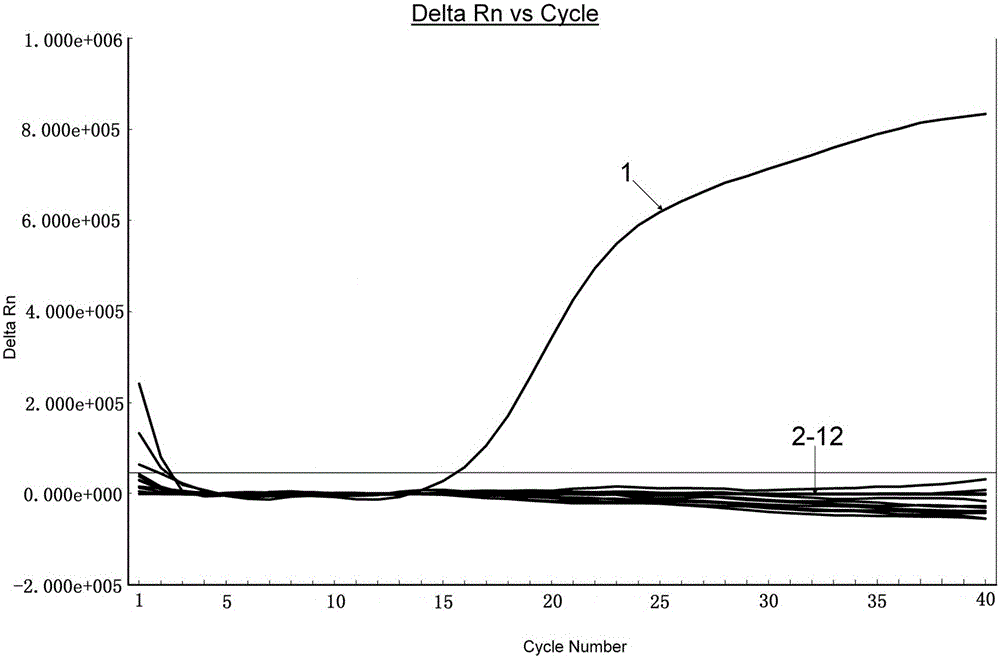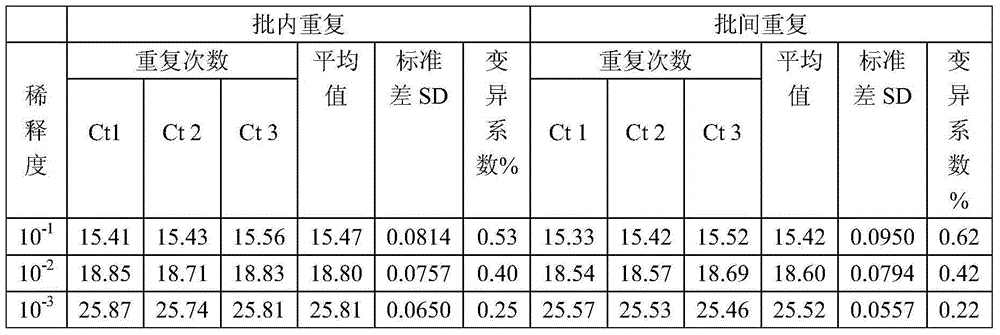Specific primers and probe by fluorogenic quantitative PCR (Polymerase Chain Reaction) for detecting sheep-derived ingredients in meat products and kit thereof
A fluorescent probe, sheep-derived technology, applied in the field of food inspection and biological detection, can solve the problems of accurate source identification, inability to destroy protein components or immunogenic components, etc., achieves simple operation, shortened detection period, repeatability Good results
- Summary
- Abstract
- Description
- Claims
- Application Information
AI Technical Summary
Problems solved by technology
Method used
Image
Examples
Embodiment 1
[0040] Example 1: Design and synthesis of primers and probes
[0041] 10 sheep mitochondrial Cytb genes published in GenBank (the accession numbers in GenBank are DQ459341, JX567831. .1, JX010746.1, AB044308.1) for sequence comparison, screen out the sheep Cytb gene conservative sequence, its nucleotide sequence is as SEQ ID NO.4 (wherein, Y, R and M are degenerate bases, Y=C or T, R=A or G, M=A or C), and use Primer5 software to design fluorescent quantitative PCR specific primers and probes used in conjunction with the primers.
[0042] The nucleotide sequence of the preferred primer is:
[0043] Upstream primer: 5'-GCATAATATTCCGMCCAATCAG-3';
[0044] Downstream primer: 5'-AGTTGTCCAATAATRATGTAGGG-3', wherein M and R are degenerate bases, M=A or C, R=A or G.
[0045] The preferred nucleotide sequence of the probe is: 5'-FAM-TCACATGAATTGGAGGMCAGCCAG-BHQ1-3', wherein M is a degenerate base, and M=A or C.
[0046] The primers and probes were synthesized by Shanghai Huirui Bi...
Embodiment 2
[0047] Embodiment 2: the extraction of sample DNA
[0048] The genomic DNA of the sample was extracted by the phenol / chloroform method, and the specific steps were as follows:
[0049] Take fresh meat, remove fat and other tissues, cut into about 1cm 2 Diced meat of different sizes, washed with distilled water, soaked overnight in water at 10°C to remove excess salt and grease, minced and dried in an oven at 80-85°C for 72 hours, then added the dried meat to the tissue homogenate Grinding and homogenizing in the machine to obtain meat samples. Take a 50 mg meat sample, add 700 μL tissue lysate and 20 μL proteinase K (20 mg / mL) to it, vortex to mix, bathe in 56°C water for 2 hours, add an equal amount of Tris to balance phenol, mix up and down, centrifuge at 10,000 rpm for 10 min; For the supernatant, add 1 / 2 volume of Tris balanced phenol and 1 / 2 volume of chloroform:isoamyl alcohol (24:1), mix well, and centrifuge at 10000rpm for 10min; then take the supernatant and transfe...
Embodiment 3
[0050] Example 3: Establishment of a fluorescent quantitative PCR detection method for detecting sheep-derived components in meat products
[0051] (1) Optimization of fluorescent quantitative PCR reaction system
[0052] Refer to the fluorescent quantitative PCR reaction system suggested by 2×PremixExTaq (ProbeqPCR) (25 μL system: 2×PremixExTaq (ProbeqPCR) 12.5 μL; the final concentration of upstream and downstream primers is 0.2 μM; the final concentration of probe is 0.4 μM; DNA template 2 μL, ddH 2 (28.5 μL) was used as the initial system to optimize the fluorescent quantitative PCR reaction system of the present invention, one condition was optimized at a time, and the remaining conditions were fixed. According to the Ct value and the strength of the fluorescent signal, the optimized reaction conditions were judged, and the best conditions were combined as the final optimized system.
[0053] The annealing temperature ranges from 55°C to 63°C, and a total of 9 gradients ...
PUM
 Login to View More
Login to View More Abstract
Description
Claims
Application Information
 Login to View More
Login to View More - R&D
- Intellectual Property
- Life Sciences
- Materials
- Tech Scout
- Unparalleled Data Quality
- Higher Quality Content
- 60% Fewer Hallucinations
Browse by: Latest US Patents, China's latest patents, Technical Efficacy Thesaurus, Application Domain, Technology Topic, Popular Technical Reports.
© 2025 PatSnap. All rights reserved.Legal|Privacy policy|Modern Slavery Act Transparency Statement|Sitemap|About US| Contact US: help@patsnap.com



